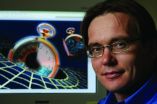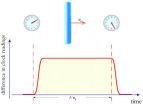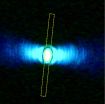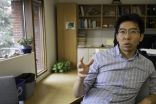(Press-News.org) RENO, Nev. - The everyday use of a GPS device might be to find your way around town or even navigate a hiking trail, but for two physicists, the Global Positioning System might be a tool in directly detecting and measuring dark matter, so far an elusive but ubiquitous form of matter responsible for the formation of galaxies.
Andrei Derevianko, of the University of Nevada, Reno, and his colleague Maxim Pospelov, of the University of Victoria and the Perimeter Institute for Theoretical Physics in Canada, have proposed a method for a dark-matter search with GPS satellites and other atomic clock networks that compares times from the clocks and looks for discrepancies.
"Despite solid observational evidence for the existence of dark matter, its nature remains a mystery," Derevianko, a professor in the College of Science at the University, said. "Some research programs in particle physics assume that dark matter is composed of heavy-particle-like matter. This assumption may not hold true, and significant interest exists for alternatives."
"Modern physics and cosmology fail dramatically in that they can only explain 5 percent of mass and energy in the universe in the form of ordinary matter, but the rest is a mystery."
There is evidence that dark energy is about 68 percent of the mystery mass and energy. The remaining 27 percent is generally acknowledged to be dark matter, even though it is not visible and eludes direct detection and measurement.
"Our research pursues the idea that dark matter may be organized as a large gas-like collection of topological defects, or energy cracks," Derevianko said. "We propose to detect the defects, the dark matter, as they sweep through us with a network of sensitive atomic clocks. The idea is, where the clocks go out of synchronization, we would know that dark matter, the topological defect, has passed by. In fact, we envision using the GPS constellation as the largest human-built dark-matter detector."
Their research was well-received by the scientific community when the theory was presented at renowned scientific conferences this year, and their paper on the topic appears today in the online version of the scientific journal Nature Physics, ahead of the print version. It can be found here: http://dx.doi.org/10.1038/nphys3137.
Derevianko is collaborating on analyzing GPS data with Geoff Blewitt, director of the Nevada Geodetic Laboratory, also in the College of Science at the University of Nevada, Reno. The Geodetic Lab developed and maintains the largest GPS data processing center in the world, able to process information from about 12,000 stations around the globe continuously, 24/7.
The two are starting to test the dark matter detection ideas by analyzing clock data from the 30 GPS satellites, which use atomic clocks for everyday navigation. Correlated networks of atomic clocks such as the GPS and some ground networks already in existence, can be used as a powerful tool to search for the topological defect dark matter where initially synchronized clocks will become desynchronized. The time discrepancies between spatially separated clocks are expected to exhibit a distinct signature.
Blewitt, also a physicist, explained how an array of atomic clocks could possibly detect dark matter.
"We know the dark matter must be there, for example, because it is seen to bend light around galaxies, but we have no evidence as to what it might be made of," he said. "If the dark matter were not there, the normal matter that we know about would not be sufficient to bend the light as much as it does. That's just one of the ways scientists know there is a massive amount of dark matter somewhere out there in the galaxy. One possibility is that the dark matter in this gas might not be made out of particles like normal matter, but of macroscopic imperfections in the fabric of space-time.
"The Earth sweeps through this gas as it orbits the galaxy. So to us, the gas would appear to be like a galactic wind of dark matter blowing through the Earth system and its satellites. As the dark matter blows by, it would occasionally cause clocks of the GPS system to go out of sync with a tell-tale pattern over a period of about 3 minutes. If the dark matter causes the clocks to go out of sync by more than a billionth of a second we should easily be able to detect such events."
INFORMATION:
Derevianko teaches quantum physics and related subjects at the University of Nevada, Reno. He has authored more than 100 refereed publications in theoretical physics. He is a fellow of the American Physical Society, a Simons fellow in theoretical physics and a Fulbright scholar. Among a variety of research topics, he has contributed to the development of several novel classes of atomic clocks and precision tests of fundamental symmetries with atoms and molecules.
Founded in 1874 as Nevada's land-grant university, the University of Nevada, Reno ranks in the top tier of best national universities. With nearly 20,000 students, the University is driven to contribute a culture of student success, world-improving research and outreach that enhances communities and business. Part of the Nevada System of Higher Education, the University has the system's largest research program and is home to the state's medical school. With outreach and education programs in all Nevada counties and home to one of the largest study-abroad consortiums, the University extends across the state and around the world. For more information, visit http://www.unr.edu.
LIVERMORE, Calif. - Lawrence Livermore National Laboratory researchers have developed an efficient method to measure residual stress in metal parts produced by powder-bed fusion additive manufacturing.
This 3D printing process produces metal parts layer by layer using a high-energy laser beam to fuse metal powder particles. When each layer is complete, the build platform moves downward by the thickness of one layer, and a new powder layer is spread on the previous layer.
While this process is able to produce quality parts and components, residual stress is a major ...
The race to make computer components smaller and faster and use less power is pushing the limits of the properties of electrons in a material. Photonic systems could eventually replace electronic ones, but the fundamentals of computation, mixing two inputs into a single output, currently require too much space and power when done with light.
Researchers at the University of Pennsylvania have engineered a nanowire system that could pave the way for this ability, combining two light waves to produce a third with a different frequency and using an optical cavity to amplify ...
Rice University scientists have invented a novel cathode that may make cheap, flexible dye-sensitized solar cells practical.
The Rice lab of materials scientist Jun Lou created the new cathode, one of the two electrodes in batteries, from nanotubes that are seamlessly bonded to graphene and replaces the expensive and brittle platinum-based materials often used in earlier versions.
The discovery was reported online in the Royal Society of Chemistry's Journal of Materials Chemistry A.
Dye-sensitized solar cells have been in development since 1988 and have been the subject ...
Scientists using a microbe that occurs naturally in eastern cottonwood trees have boosted the ability of two other plants - willow and lawn grass - to withstand the withering effects of the nasty industrial pollutant phenanthrene and take up 25 to 40 percent more of the pollutant than untreated plants.
The approach could avoid the regulatory hurdles imposed on transgenic plants - plants with genes inserted from or exchanged with other plant or animal species - that have shown promise in phytoremediation, the process of using plants to remove toxins from contaminated sites, ...
More than a decade ago, researchers from Brigham and Women's Hospital (BWH) demonstrated that a high dose statin, which lowered cholesterol further than a regular dose statin, provided better clinical outcomes. But questions remained about whether further reducing cholesterol would be even more effective in reducing cardiovascular-related events.
Now, results of the highly anticipated IMProved Reduction of Outcomes: Vytorin Efficacy International Trial (IMPROVE-IT), co-led by researchers at BWH and Duke Medicine, indicate that adding a second drug, ezetimibe, that blocks ...
WCS, NASA, And other conservation and remote sensing agencies, universities and NGOs focus on top 10 conservation questions for satellite technology
Remote sensing has and can continue to play a critical role in conserving Earth's biological diversity
Protected area management is a key use of remote sensing data
Newly formed Conservation Remote Sensing Network to apply remote sensing data to conservation challenges
NEW YORK (November 17, 2014)--Scientists from the WCS (Wildlife Conservation Society), NASA, and other organizations have partnered to focus global attention ...
Harvard Stem Cell Institute (HSCI) researchers, representing five Harvard departments and affiliated institutions as well as the Massachusetts Institute of Technology (MIT), have demonstrated that adult cells, reprogrammed into another cell type in a living animal, can remain functional over a long period.
The work by Joe Zhou, an associate professor in Harvard's Department of Stem Cell and Regenerative Biology, and his collaborators is an important advance in the effort to develop cell-based therapies for tissue repair, and specifically in the effort to develop improved ...
HOUSTON - (Nov. 17, 2014) - Offering small financial incentives doubles smoking cessation rates among socioeconomically disadvantaged smokers, according to research from The University of Texas Health Science Center at Houston (UTHealth). The findings were published last week in the American Journal of Public Health.
Tobacco use is the leading cause of preventable death in the United States, according to the Centers for Disease Control and Prevention. Thanks to public health efforts, smoking rates have declined to 18 percent among American adults. However, nearly 30 percent ...
If your surname reveals that you descended from the "in" crowd in the England of 1066--the Norman Conquerors--then even now you are more likely than the average Brit to be upper class. To a surprising degree, the social status of your ancestors many generations in the past still exerts an influence on your life chances, say Gregory Clark of the University of California, Davis, in the US and Neil Cummins of the London School of Economics in the UK. They used the Oxbridge attendance of people with rare English surnames (last names) to track social mobility from 1170 to 2012. ...
(NEW YORK - November 17) Brief usage of the painkiller oxycodone may impair behavioral flexibility even after that use ends, suggesting impaired decision-making as an enduring consequence of exposure, according to a study conducted at the Icahn School of Medicine at Mount Sinai and published November 17 in the journal Learning and Memory.
The Mount Sinai study investigated behavioral flexibility, the ability to select new responses when otherwise familiar circumstances change. In people and rodents exposed to drugs of addiction, repeated actions can become automated ...






